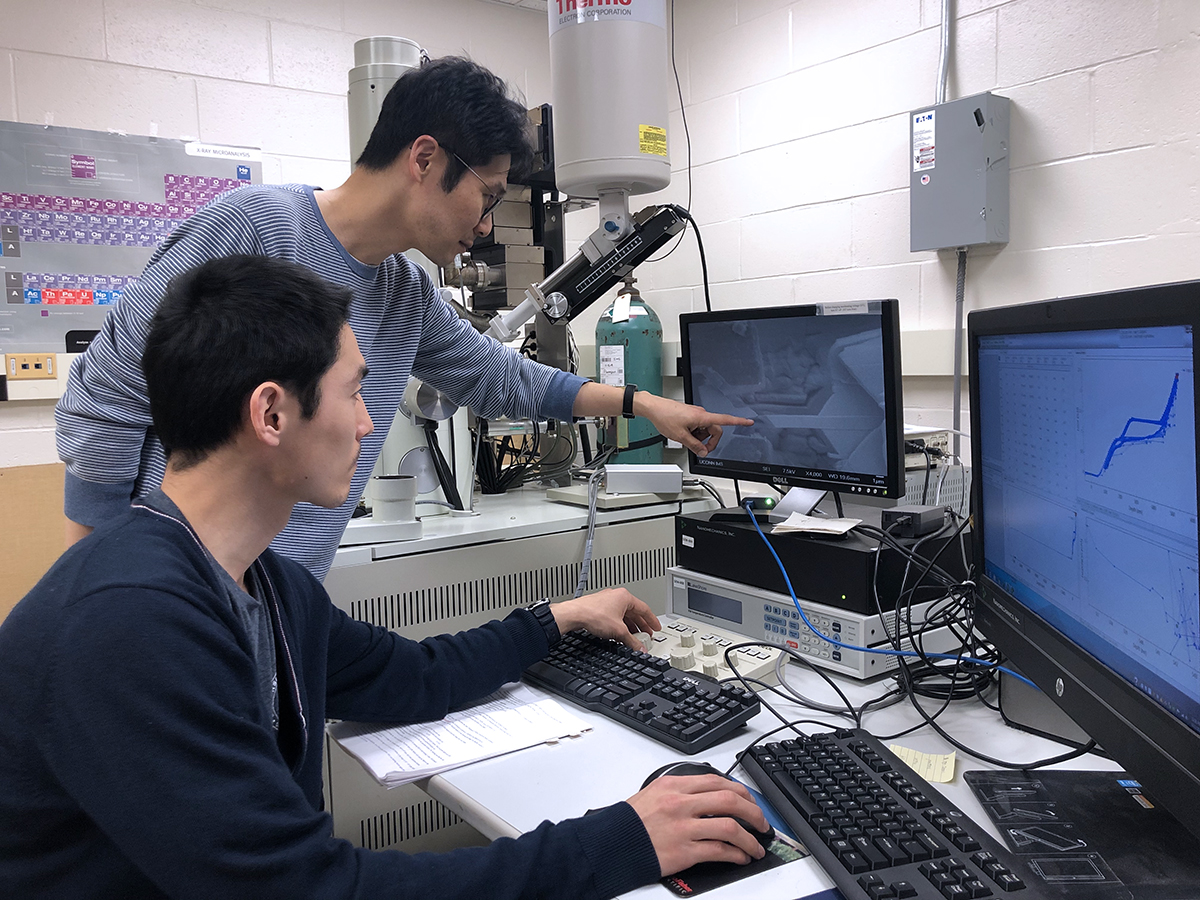MSE Professor’s Research is More Than What Meets the Eye
By Ben Crnic

Dr. Seok-Woo Lee and Gyuho Song (5th year Ph.D. student) conduct an in-situ micro-mechanical measurement.
Many of the materials that UConn MSE Assistant Professor Seok-Woo Lee works with in his research are invisible to the naked eye. In order to even see them, an electron microscope is required. Some samples are more than 100 times thinner than a human hair. Despite this, the nanomaterials that Lee researches are crucial to producing mechanically robust devices and structures.
According to Lee, creating resilient small materials is important for smaller machines.
“In order to develop a mechanically reliable robot or machine at the nano-/micro-meter scale, we need to know how to create a strong and tough ‘small’ material,” Lee said. His research group is working on understanding how characteristics of materials can influence mechanical behaviors of substances including metals, ceramics, intermetallic compounds, and polymers.
One such way to control mechanical behavior is reducing the size of materials. As a material’s size decreases from macro to nano-/micro-meter scales, it usually becomes much stronger and tougher. However, this can change as temperatures become more extreme. Part of Lee’s research involves exposing micromaterials such as metals to very cold temperatures, where they become brittle and fracture easily. Lee is attempting to find a way to avoid this.
It is important to understand how materials may respond in extremely cold environments for applications such as the vacuum of space. One example is called a cryogenic shape memory material, which can recover its original shape even after being largely deformed. The process of recovering its shape by expanding or contracting can be used to create mechanical motion.
“This long-range motion can turn on an electrical switch for a cold, dormant satellite in deep space once it meets a heat source such as a star. Also, this material can be used to move a mechanical component to control a robotic arm or telescope lens that is used under cold environments such as the shadow area of the moon,” Lee said.
Although Lee is dedicated to his research, he mainly sees himself as a teacher.
“Teaching is very important to me because I have always believed that I am basically a teacher. Once a student receives a good lecture, they can remember what they learn for a longer time,” Lee said.
Lee has received multiple awards for his teaching, including the UConn Mentorship Excellence Award in 2019 and UConn MSE Teaching Excellence of the year in 2017 and 2018. Lee is proud of being recognized for educating.
Lee has both undergraduate and graduate students, and over time, he has learned that they both require different approaches. According to him, the major difference is independence when it comes to performing research.
“A graduate student can design and perform experiments by themselves. However, I usually assign a simple and relatively straightforward research topic to undergraduate students because they are very busy due to their classes. I usually give step-by-step instructions to an undergraduate student, then they can learn the details of the research even without much prior experience,” said Lee. The graduate students Lee works with handle the microscopic material that he researches and are able to “pull and push a sample with an extremely precise control of force,” Lee said. An electron microscope has to be used in order to see these samples, as they are too small to be visible in a regular optical microscope.
According to Lee, it is fun for him to work with the three undergraduates and five graduate students who are part of his research group. He feels his MSE students should be especially proud of their major.
“I want to tell our MSE students that their decision to study MSE is a great choice. More and more I see that technological breakthroughs require the development of new advanced materials. Creating high-performance engineering devices such as micro-processors, airplanes, satellites, etc. requires sophisticated materials design and processing. Because of this, studying MSE becomes more important in overcoming our technological limits. So, I really think they should be proud to be MSE majors,” Lee said.
In addition to his work with students, Lee also collaborates with other faculty members on research. One such project is a cold spray project for the US Army, which he is working on with MSE professors Avinash Dongare, Mark Aindow, and Harold Brody. Lee enjoys these collaborations, which helped influence his decision to come to UConn.
“I chose UConn because of great people here. All of the faculty and students I met during the interview were very nice and friendly to me. I always believe that working with wonderful people is very important, and I thought (and still think) that those people are here at UConn,” said Lee.
Lee discovered materials science when he was in high school. He always wanted to combine his love of physics and chemistry with “making something useful,” which was fulfilled by materials science and engineering.
“I found that materials science and engineering is the best program because I can do both science and engineering! Also, I always wondered how matter was formed after the beginning of the universe, and I thought that it would be wonderful if I could design and create a special matter under my own control,” Lee said.
This interest followed Lee to his current career, and he is optimistic about his students also being a part of the MSE field.
“They can use this knowledge of materials to improve our world,” Lee said.
Published: April 1, 2020
Categories: faculty, micro/nano-CT laboratories, microscopy, news, research
Available Archives